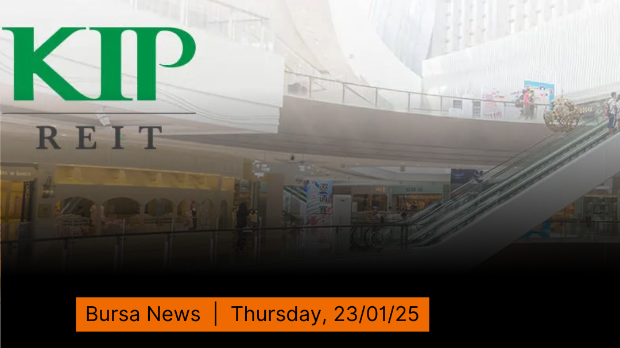Daily Brief - 18 Jul 2024
sectoranalyst
Publish date: Thu, 18 Jul 2024, 09:53 AM
Construction & Property as Market Drivers
The local blue-chip benchmark bounced back to trade at fresh three-year highs on Wednesday, boosted by the overnight rally on the US Dow Jones average to record highs as traders were more certain the Fed will pivot to interest rate cuts soon. The FBM KLCI ended up 7.58 points at 1,633.54, off an opening low of 1,629.89 and high of 1,638.03, as gainers led losers 770 to 445 on higher turnover of 5.28bn shares worth RM3.88bn.
Resistance at 1,638/1,640; Supports at 1,620/1,609
Buying momentum surge will be crucial to absorb profit-taking and sustain the index’s rise to three-year highs, with situational plays on the construction and property sectors seen to drive positive market tone. Immediate index resistance will be at yesterday’s high of 1,638, with
1,640 and 1,660 as tougher upside hurdles, while immediate supports are at 1,620, 1,609 and 1,601, the respectively rising 10-day, 30-day and 50-day moving average levels.
Bargain Hartalega & Kossan
Hartalega will need to overcome the 138.2%FP (RM3.68) to enhance upside momentum and aim for the 150%FP (RM3.87) and 161.8%FP (RM4.07) ahead, while uptrend supports from the rising 50-day ma (RM3.32) and 100-day ma (RM2.98) cushion downside. Kossan need breakout confirmation above the 138.2%FP (RM2.59) to extend uptrend momentum and target the 150%FP (RM2.71) and 161.8%FP (RM2.83) going forward, with the 50-day ma (RM2.37) and 100-day ma (RM2.17) acting as uptrend supports.
Asian Markets Mixed as Traders Digest Economic Data
Asian markets traded mixed on Wednesday as traders assessed economic data from the region and stronger-than-expected retail sales report from the U.S. Gains for risk assets reflected growing confidence among investors that the Fed is inching toward a rate cut. Data showed U.S. retail sales unchanged in June from a May reading that was higher than initially estimated. The data was taken as supporting prospects the Federal Reserve will ease rates to rein in inflation while aiming to avoid a recession. Stocks in Hong Kong and mainland China fluctuated as traders awaited more details from the Third Plenum. On regional front, Japan’s Tankan survey showed an increase in business optimism among large Japanese manufacturers.
Separately, Singapore’s non-oil domestic exports slipped more than expected in June, marking a fifth straight month of declines. Meanwhile, increasing chances of a Donald Trump presidency also raised concerns over geopolitical and trade risks over the past few sessions. Japan’s Nikkei 225 fell 0.43% to 41,097.69, while the Topix gained 0.37% to 2,915.21. South Korea’s Kospi fell 0.80% to 2,843.29 and Australia’s S&P/ASX 200 rose 0.73% to 8,057.80. The Shanghai Composite Index slipped 0.45% to 2,962.85, while Hong Kong’s Hang Seng gained 11.43 points to 17,739.41.
Wall Street Finish Mixed as Tech Slump
Wall Street’s main indexes ended mixed overnight, with the S&P 500 and Nasdaq dropping sharply as techs came under pressure from worries about US export curbs on China. The Dow Jones Industrial Average rose 0.59% to 41,198.08. The S&P 500 fell 1.39% to 5,588.27 and the Nasdaq Composite dropped 2.77% to 17,996.92. Semiconductor stocks are turning in some of the market's worst performances on the day, resulting in a 4% nosedive by the Philadelphia Semiconductor Index. The sell-off by semiconductor stocks comes after a report from Bloomberg said President Joe Biden's administration is considering tougher trade rules against companies in its chip crackdown on China. Negative sentiment was also generated after former President Donald Trump suggested Taiwan should pay the U.S. for defense, claiming the country took "about 100%" of America's chip business.
Information technology and communication services were the two worst performing S&P 500 sectors in the session. Meta tumbled more than 6%, while big tech peers Apple, Netflix and Microsoft all dropped more than 1%. A gain of about 4.5% in UnitedHealth following a Wall Street upgrade on the back of its strong earnings report helped lift the Dow. On the economic front, housing starts and building permits surprised to the upside, as strength in multiple-unit projects offsets a dip in single-family homebuilding. In a separate report, industrial output rose at double the expected rate in June.
Source: TA Research - 18 Jul 2024
Related Stocks
| Chart | Stock Name | Last | Change | Volume |
|---|
More articles on TA Sector Research
Created by sectoranalyst | Jan 27, 2025


















